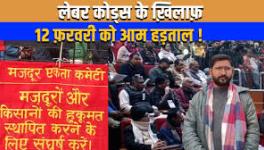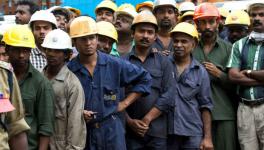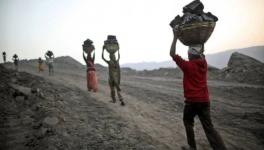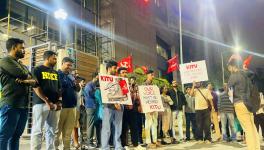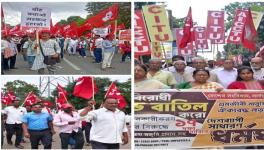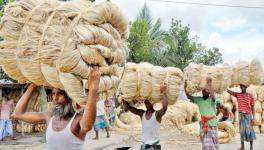Former Mine Workers in Ballari Refuse to Leave Quietly
Mine workers protest at the DC office in Ballari
Lakshmakka, 60, a mine worker from Rajapura village, Ballari, shows a photo of her late husband, Gurumurthy. He was a worker at a Manganese mine and had died of kidney failure several years before the Ballari (then Bellary) mining ban of 2011.
However, she did not receive a single rupee as compensation for his death. All she had was the meagre job at the mine, where she would earn just enough to survive. She worked as a crusher, manually smashing large boulders of Manganese ore into smaller chunks. Then, she would load the material onto a truck. Until 2003, this job was done manually.
Lakshmakka, from the scheduled tribe Valmiki community, did this work for more than 30 years. She says that she was paid Rs 1.50/tonne at that time. One truckload would be around 15 tonnes of material, so her daily wages came up to Rs 20. When the Supreme Court banned mining in Ballari, she lost her only source of income.
It is estimated that along with Lakshmakka, around 25,000 workers lost their jobs overnight when a total ban on mining was imposed in the districts of Ballari, Chitradurga and Tumkur in 2011. This week, these workers, some of whom have unionised, marched to the Ballari DC office from Sandur.
Lakshmakka shows a photo of her late husband, Gurumurthy
The journey was 70 km long and took three days to cover. But they are determined to take their rightful compensation from a fund worth 18000 crores.
CONTEXT OF MINING BAN IN KARNATAKA
The ban on mining was primarily implemented for environmental reasons. Rampant, illegal mining in forest areas was destroying the natural ecosystem and the local wildlife. The dust from the mines, laced with chemical toxins, was poisoning the waters and destroying crops in agricultural areas. Waste from the mines was being illegally dumped in forest lands, and erosion of topsoil was reducing arable land. Manganese and Iron ore are raw materials used in the production of Steel. The grade of the ore determines the price it will fetch. Iron ore with 65% or higher iron content (65 Fe) is considered a high grade.
If the grade is too low, it is just dumped in the forest. The chemicals in the ore spread toxins into the ecosystem. In Karnataka, Ballari was the epicentre of iron ore mining. The district lies on the border of Karnataka and Andhra Pradesh. Along with large reserves of Iron ore, Manganese, Gold, Granite, Quartz and Limestone, it also has dense forests. Illegal extraction and smuggling of iron ore were rampant.
Most of the mining leases were in the hands of private companies, and proximity to political power helped secure mining rights. Forest land was encroached on and plundered.
All these findings were published by the Karnataka Lokayukta Justice Santhosh Hegde, in his reports on illegal mining in Karnataka, first in 2008 and the second in 2011. His second report indicted more than 700 officials, including then BJP Chief Minister BS Yeddyurappa, who was forced to resign. Co-incidentally, it was 2008 when BJP had formed a majority on their own for the first time in the Karnataka state assembly.
After the submission of the first report in 2008, a social activist called SR Hiremath filed a writ petition in the Supreme Court. Through his organisation, Samaj Parivartana Samudaya, he appealed to the court to take cognisance of the illegal mining in forest areas of Karnataka and Andhra Pradesh. Speaking to NewsClick, Hiremath laid out the details of the case. He said, "the Supreme Court constituted a Central Empowered Committee (CEC) to investigate illegal mining activities in the two states.
In 2011, the CEC reported outlined violations of a colossal scale. The errant mining companies were classified under three categories - A, B and C based on the extent of violations and encroachment. The CEC recommended the cancellation of licenses of companies that fell under the C-category and for the auction of iron ore stocks held by them. It also suggested levying heavy fines on A and B Category companies. The money raised by these auctions and fines could be used for reclamation and rehabilitation (R&R) of forest areas consumed by illegal mining."
The Supreme Court ordered a ban on mining in three districts of Karnataka so that the CEC recommendations could be implemented. This is where the mine workers enter the picture, or rather, remain conspicuously absent from it.
According to a report in the Deccan Herald, the fund for R&R activities now stands at Rs 18,000 crore. However, no plan has been drawn up to compensate mine workers who lost their jobs overnight. For thirty years, the mines were the largest source of employment for the people who resided in the villages of Sandur and Hospet taluk. There was no other alternative source of employment, and the mine workers did not have any land to their name. The CEC recommended that housing be provided to workers who were affected by the closure of mines.
Appanna, of Aicctu, raises a slogan
However, there was no specific mention of compensation. In 2013, the aggrieved workers came together to form the Bellary Zilla Gani Karmikara Sangha to pressure the government to consider their rights and entitlements. Close to 5,000 mine workers joined the union. They also affiliated with the All India Central Council of Trade Unions (AICCTU) after receiving legal help from their leaders, Clifton D'Rosario and Maitreyi Krishnan.
WORKERS TAKE ON BUREAUCRACY
In 2013, the A and B-category mines were allowed to reopen after seeking regulatory approvals. However, the companies hired new contractors who brought in cheap migrant labour from other states.
Gopi Y, President of the Bellary Zilla Gani Karmikara Sangha, spoke to NewsClick about the legal hurdles faced by the union.
He said, "We filed a complaint in 2013 with the regional labour commissioner (RLC) in Ballari demanding compensation from the mining companies where workers lost their jobs. When the mines reopened, they cited the case we filed and refused to rehire the unionised workers.
They also found new contractors who supplied cheap migrant labour from other states. Our complaint was then referred to the undersecretary at the Ministry of labour and employment in New Delhi. Out of cases related to 28 companies, eight were then referred to the Central Government Industrial Tribunal (CGIT) in Bengaluru. However, those cases are not moving either because the government has not appointed a judge for that labour court, and the position is lying vacant."
On October 11, 2022, around 250 mine workers marched from Sandur taluk to Ballari city to protest for their share of the r&r package. They also undertook the 70 km padayatra in the hopes of seeking employment in the reopened mines.
LIFE AFTER MINING BAN
Ravi, 52, was a worker at iron ore mines for 35 years. He is from a village called Narsapura in the Ballari district. At the time of the ban in 2011, his salary was Rs 6,000 per month. He worked as a crusher and used to manually smash the extracted iron ore into smaller sizes so that it could be further processed and refined.
Speaking to NewsClick, he said, "after the ban on mining, I had to work as a daily wage labourer. My earnings dropped. I found work for only 2-3 days per week. It was a struggle to find regular work, and I did whatever I could to sustain my family. When the mines closed, I expected some compensation or settlement amount, but I did not receive anything. I withdrew Rs 25,000, which was there in my PF account. If I get work at the mines at Sandur or Hospet, I will go back there."
Rajavali, 46, one of the protesters, worked at the mines from the year 2000. He spoke about the flight of workers after the mining ban.
Speaking to NewsClick, he said, "Life was extremely hard after we lost our job at the mine. I did odd jobs wherever possible. I occasionally found work as a driver. Many of the workers left Ballari and went to work in coffee plantations in Chikmagalur. Mostly we had to work as daily wage labourers. Later, I found some contract work at the National Mineral Development Corporation (NMDC) mine. I got a job on a two-year contract, and after that, I was without work again. I have four children. I am hoping we get a share in the R&R settlement.”
The workers alleged that the mine owners never used to pay even the minimum wage. The working hours were long, and they received no medical help if they fell sick or were afflicted with diseases. An expert in Public Health, Dr Sylvia Karpagam, spoke to NewsClick about the common ailments faced by mine workers. She said, "Workers at iron ore mines are prone to a host of diseases and ailments, including Asthma, cancer, and organ failure. In the case of manganese poisoning, workers are at risk of a breakdown of the central nervous system. They may exhibit symptoms in the Parkinson's spectrum."
When asked about Gurumurthy's kidney failure, she said it would not be possible to identify the cause without looking at medical history. She said, "the mining companies must maintain medical records of the workers and also have a doctor onsite for providing prompt treatment."
The workers in Ballari never received adequate medical care despite the colossal sums of money raked in by mine owners. In case of accidents and serious injuries, they were provided with on-the-spot medical care and fired.
On October 13, 2022, after the three-day padayatra, the protesting mine workers reached the office of the Deputy Commissioner (DC) at Ballari. The Assistant Commissioner met the protestors and promised to consider the proposals of the union. He set up a meeting with union leaders on October 19.
As the protest drew to a close, the workers began immediately leaving for their hometowns. Ravi and Lakshmana were waiting by the gate of the DC office, hoping to hitch a ride in a cargo vehicle belonging to the union. Both of them are from Narsapura village in Ballari. Taking turns, they spoke about the absence of regular work.
The Padayatra enters Ballari city
"We do coolie (daily wage labour) work. But this depends on demand. We may get work 2-3 days a week. We are paid Rs 350-450 per day. We don't let the women in our family go to work. If they go, they will earn Rs 100/day. What can we buy with Rs 100? If we fall sick and get admitted, the bill will be Rs 1,000," Lakshmana says.
He also speaks about his health problems. "I cannot eat properly. I have gastric issues. I have pain all over my body, especially my back and my knees. But even when I feel tired, I will go to work for the sake of my kids. We know that the minimum wage for daily labour is Rs 500. But the contractor will never pay us the full amount. If we question him, he will just replace us with someone else. All the mines in Ballari are now using migrant workers from outside because they think that we will strike and ask for more pay."
They spot a union jeep exiting the DC office. They say a quick goodbye and chase after it.
Get the latest reports & analysis with people's perspective on Protests, movements & deep analytical videos, discussions of the current affairs in your Telegram app. Subscribe to NewsClick's Telegram channel & get Real-Time updates on stories, as they get published on our website.










